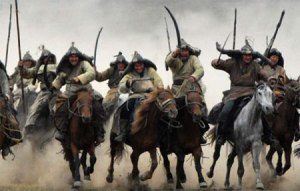
Who would have predicted that conflict and destruction would beget the flowering of large scale ancient complex societies? Intuitively, for most people at least, they don’t seem to mix. But the recent development and testing of a mathematical model seems to support that otherwise unlikely paradigm.
The model was developed by an international team from the University of Connecticut, the University of Exeter in England, and the National Institute for Mathematical and Biological Synthesis (NIMBioS). By focusing on the interaction of ecology and geography as well as the spread of military innovations, the cultural evolutionary model predicts that selection for social organizations that facilitate cooperation in large groups of genetically unrelated individuals, leading to large-scale complex states, is greater where warfare is more intense. Amazingly, when the model was run as a simulation, it closely matched the actual record of how and when the largest-scale complex societies in the Old World arose in human history.
The model was simulated within a realistic landscape of the Afro-Eurasian landmass during 1,500 BCE to 1,500 CE, and it was able to explain two-thirds of the variations involved in the evolution of large-scale societies. When compared to actual history, for example, it predicted that horse-related military innovations, such as chariots and cavalry, dominated warfare within Afro-Eurasia and that nomads living in the Eurasian Steppe influenced agrarian societies nearby, resulting in the spread of intense warfare beyond the steppe.
“What’s so exciting about this area of research is that instead of just telling stories or describing what occurred, we can now explain general historical patterns with quantitative accuracy,” said the study’s co-author Sergey Gavrilets, who is NIMBioS director for scientific activities. “Explaining historical events helps us better understand the present, and ultimately may help us predict the future.”
Details of the study have been published as War, space, and the evolution of Old World complex societies n the open-access journal Proceedings of the National Academy of Sciences (PNAS).
__________________________
Cover Photo, Top Left: Mongol horsemen
_______________________________________________________________________________________________________________________
Read about the most fascinating discoveries with a premium subscription to Popular Archaeology Magazine. Find out what Popular Archaeology Magazine is all about. AND MORE:
 Popular Archaeology’s annual Discovery edition is a selection of the best stories published in Popular Archaeology Magazine in past issues, with an emphasis on some of the most significant, groundbreaking, or fascinating discoveries in the fields of archaeology and paleoanthropology and related fields. At least some of the articles have been updated or revised specifically for the Discovery edition. We can confidently say that there is no other single issue of an archaeology-related magazine, paper print or online, that contains as much major feature article content as this one. The latest issue, volume 2, has just been released. Go to the Discovery edition page for more information.
Popular Archaeology’s annual Discovery edition is a selection of the best stories published in Popular Archaeology Magazine in past issues, with an emphasis on some of the most significant, groundbreaking, or fascinating discoveries in the fields of archaeology and paleoanthropology and related fields. At least some of the articles have been updated or revised specifically for the Discovery edition. We can confidently say that there is no other single issue of an archaeology-related magazine, paper print or online, that contains as much major feature article content as this one. The latest issue, volume 2, has just been released. Go to the Discovery edition page for more information.
Subscription Price: A very affordable $5.75 for those who are not already premium subscribers of Popular Archaeology Magazine (It is FREE for premium subscribers to Popular Archaeology). Premium subscribers should email populararchaeology@gmail.com and request the special coupon code. Or, for the e-Book version, it can be purchased for only $3.99 at Amazon.com.





